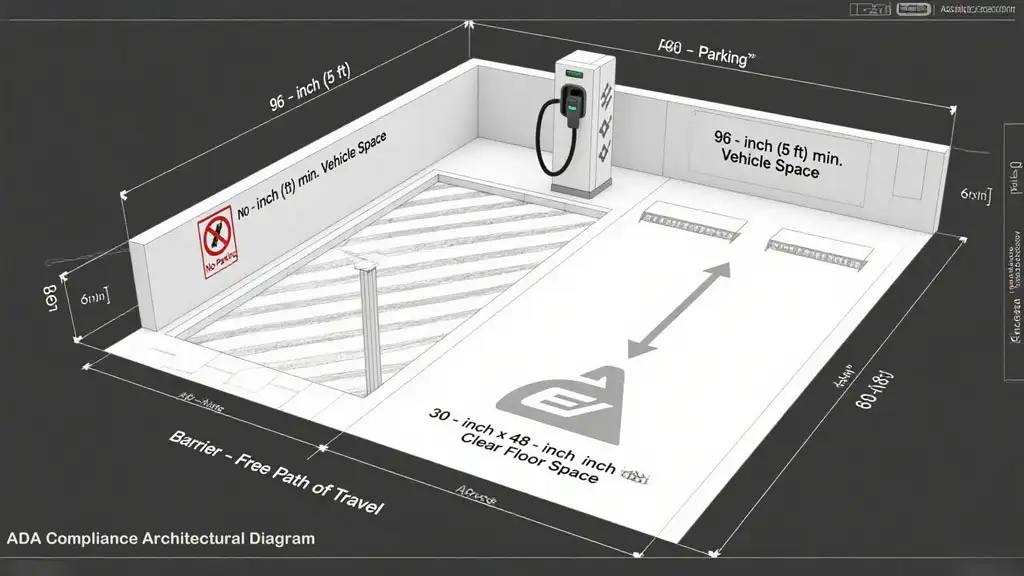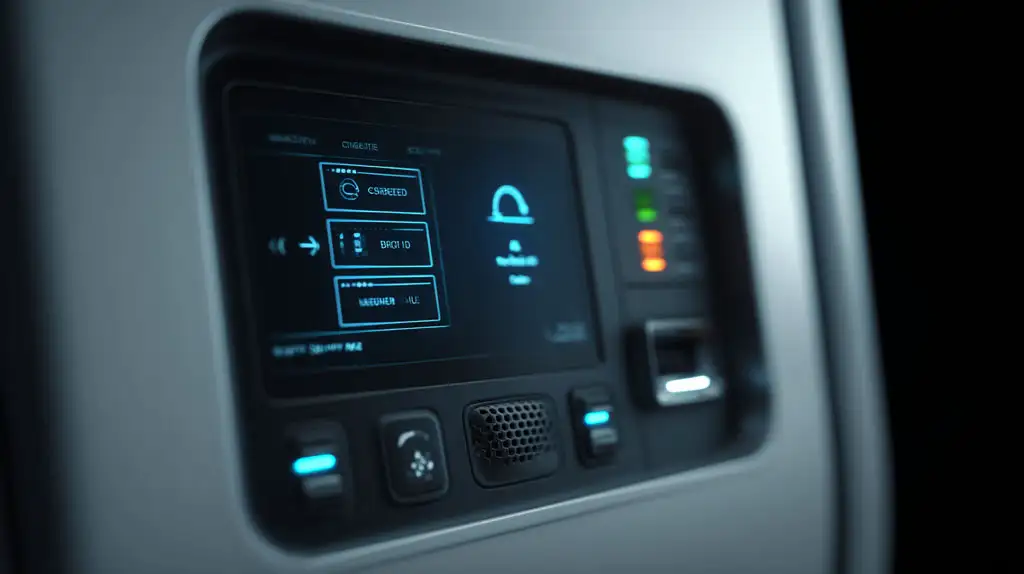As a business or property owner, installing electric vehicle chargers is a smart move for the future. However, ensuring they are accessible to all users is not just good business—it’s the law. This guide provides a clear roadmap to understanding and implementing ADA compliant EV charging stations.
A fully compliant solution rests on four key pillars:
Accessible Site Design: Providing properly sized parking spaces and clear paths of travel.
Compliant Hardware: Choosing electric vehicle equipment that everyone can reach and operate.
Smart Cable Management: Ensuring charging cables do not create tripping hazards or barriers.
Usable Interfaces: Designing screens and software that are accessible to people with visual or other disabilities.
By addressing these four areas, you can create a safe, welcoming, and legally compliant charging experience that serves 100% of your community.

Many view compliance as a cost. In reality, it is a direct path to a better, more profitable business. The business opportunities in EV are immense for those who prioritize accessibility from day one.
Expand Your Customer Base: The CDC reports that 1 in 4 American adults lives with a disability. By creating an accessible station, you are opening your doors to millions of potential customers who are often overlooked.
Enhance Your Brand Reputation: An inclusive and accessible facility shows that your company cares about the entire community. This builds immense public goodwill and a positive brand image.
Increase Your Revenue Potential: More customers mean more transactions. By being the most accessible option in your area, you ensure your eV charging stations are profitable and serve the widest possible audience.
Avoid Significant Legal Risk: Non-compliance with the Americans with Disabilities Act (ADA) can lead to significant lawsuits, fines, and mandated retrofitting costs. Proactive compliance is the most cost-effective strategy.
The primary law governing accessibility in the United States is the Americans with Disabilities Act (ADA) of 1990. The U.S. Access Board is the federal agency responsible for issuing the specific guidelines for compliance.
While the Access Board has published technical assistance, the rules for EV charging are still evolving. This makes it crucial to follow the established best practices outlined in the ADA Standards for Accessible Design. These are not just suggestions; they are the enforceable standards for creating accessible spaces. Adhering to all EV Charging Standards, including accessibility, is fundamental.

The physical layout of your station is the foundation of accessibility. A successful EV charging station design must incorporate these elements from the very beginning.
An accessible charging space is more than just a sign.
Number of Spaces: A certain percentage of your total charging spots must be ADA accessible.
Parking Space Size: The vehicle space must be at least 96 inches (8 feet) wide.
Access Aisle: The space must have an adjacent access aisle that is at least 60 inches (5 feet) wide. This aisle allows a person using a wheelchair to deploy a ramp and maneuver out of their vehicle. It must be marked to prohibit parking.
This is a non-negotiable requirement.
Minimum Space: You must provide a clear, level floor or ground space of at least 30 inches by 48 inches in front of the charger.
Positioning: This space should be positioned to allow either a forward or parallel approach to the charger’s controls.
Slope: The slope of this space cannot be steeper than 1:48 (a 2% grade) in any direction to ensure stability for a wheelchair.
A user must be able to physically reach and use every part of the charger.
Height: All operable parts—including the screen, card reader, buttons, and plug handle—must be within the ADA’s maximum reach ranges. Generally, this is no higher than 48 inches from the ground.
Force: Activating the charger (like pressing a button) should not require tight grasping, pinching, or more than 5 pounds of force.
The charging cable itself can be a major barrier if not managed correctly.
Reach: The cable must be long enough to easily reach the charging port of a vehicle parked in the space.
No Tripping Hazards: An effective EV cable management system is required. This means using retractors or other systems to keep the cord off the ground when not in use, preventing it from becoming a tripping hazard or blocking the path of travel.

True accessibility doesn’t stop at the curb. The user interface on the charger and its associated mobile app must also be usable by everyone.
Visibility: Screens should be mounted to avoid glare and be readable from both a standing and seated position.
Text & Contrast: Text characters should be large and in a high-contrast color scheme (e.g., light text on a dark background).
Audible Instructions: The station should provide audible output for users who are blind or have low vision.
Mobile App Design: Any mobile app used to activate the charger should be designed to work with screen reader software (like VoiceOver on iPhone or TalkBack on Android).
Investing in a compliant installation is a necessary part of the project budget. While it may add to the initial charging station cost, the return on investment is clear.
Investment Area | Why It’s Worth It |
Larger Parking Spaces & Aisles | Provides required legal access, opens your business to more customers. |
Accessible Hardware & Software | Ensures every user can complete a transaction, maximizing revenue potential. |
Expert Design & Installation | Avoids costly fines and retrofits from non-compliance, ensuring a lower TCO. |

In 2025, creating ADA compliant EV charging stations is a fundamental requirement for any public or commercial installation in the United States. It is the hallmark of a professional, inclusive, and future-proof project.
Your path to success depends on your goals:
For Architects and Planners: Your primary focus is integrating the physical requirements from the U.S. Access Board guidelines into your site plans from day one.
For Business and Property Owners: Your goal is to choose a turnkey partner who understands both the physical and digital aspects of compliance. This partner should guide you through the entire process, from design to installation, protecting you from legal risk and helping you serve the entire community.
Accessibility is not a feature; it’s a foundation. By building on this foundation, you create a charging destination that is truly open for everyone.
Authoritative Sources
U.S. Access Board – Main Website:
U.S. Department of Justice – ADA.gov Information Portal:
The ADA National Network – Information & Guidance:
Vi kommer att skicka detaljerad teknisk information och offert till dig!